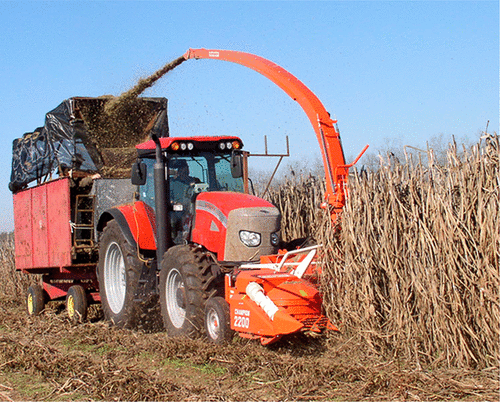当前位置:
X-MOL 学术
›
ACS Sustain. Chem. Eng.
›
论文详情
Our official English website, www.x-mol.net, welcomes your
feedback! (Note: you will need to create a separate account there.)
Field Productivities of Napier Grass for Production of Sugars and Ethanol
ACS Sustainable Chemistry & Engineering ( IF 7.1 ) Pub Date : 2020-01-17 , DOI: 10.1021/acssuschemeng.9b06637 Bruce S. Dien 1 , William F. Anderson 2 , Ming-Hsun Cheng 3 , Joseph E. Knoll 2 , Marshall Lamb 4 , Patricia J. O’Bryan 1 , Vijay Singh 3 , Ronald B Sorensen 4 , Timothy C. Strickland 5 , Patricia J. Slininger 1
ACS Sustainable Chemistry & Engineering ( IF 7.1 ) Pub Date : 2020-01-17 , DOI: 10.1021/acssuschemeng.9b06637 Bruce S. Dien 1 , William F. Anderson 2 , Ming-Hsun Cheng 3 , Joseph E. Knoll 2 , Marshall Lamb 4 , Patricia J. O’Bryan 1 , Vijay Singh 3 , Ronald B Sorensen 4 , Timothy C. Strickland 5 , Patricia J. Slininger 1
Affiliation

|
Napier grass (Pennisetum purpureum (L) Schum) is being developed as a bioenergy crop for production in the southeastern United States. Important criteria for selecting a feedstock are cost, consistent biomass production, composition, and process related quality. In this study, we considered the effects of fertilizer application and cutting regimes on production yield, chemical composition, and process yields. Napier grass was grown for 4 years in field plots (Shellman, GA) with three treatments, which were selected to maximize production yields and replicated in four subplots. The treatments varied by cuttings (one or two) and number of fertilizer applications (either all at once or split in two). It was observed that multiple seasonal cuts negatively impacted production yield by 21% over the 4 year period. Samples from years 2 and 4 were analyzed for composition. Glucan, xylan, and acid insoluble lignin differed among the samples. Carbohydrate yields were 11.1–25.7 Mg/ha. Samples were pretreated with low moisture ammonia hydroxide (110 °C, 2 days) and evaluated for conversion to sugars, using commercial cellulases, as well as to ethanol using separate hydrolysis and fermentation with Scheffersomyces stipitis. Glucose and xylose yields were 317–379 kg/Mg and 141–164 kg/Mg, respectively, for years 2 and 4. Ethanol yields were 268–313 L/Mg or 61.3–79.3% of maximum. This equates to annual ethanol yields of 5.9–12.8 m3/ha. Ethanol yields for year 4 were over 50% higher for the crop harvested in winter versus the crops harvested in summer and winter. The ethanol production per hectare from winter harvested Napier grass is comparable to that of grain-based biofuel crops.
中文翻译:

纳皮尔草用于生产糖和乙醇的田间生产力
内皮草(狼尾草(L)Schum)被开发为一种生物能源作物,在美国东南部生产。选择原料的重要标准是成本,稳定的生物质生产,组成和与过程相关的质量。在这项研究中,我们考虑了肥料施用和切割方式对产量,化学成分和加工产量的影响。纳皮尔草在田间样地(谢尔曼,乔治亚州)种植了4年,共进行了3种处理,这些处理经过选择以最大化产量,并在4个子图中重复进行。处理方式因cutting插(一或两次)和施肥次数(一次全部或分成两份)而异。观察到,季节性的多次削减对四年来的产量造成了21%的负面影响。分析来自第2年和第4年的样品的成分。葡聚糖,木聚糖,样品中酸不溶性木质素也不同。碳水化合物产量为11.1–25.7 Mg / ha。样品用低水分氢氧化氨(110°C,2天)进行预处理,并使用商业纤维素酶评估其转化为糖的能力,并使用单独的水解和发酵工艺评估其转化为乙醇的能力裂殖酵母。在第2年和第4年,葡萄糖和木糖的产量分别为317-379 kg / Mg和141-164 kg / Mg。乙醇的产量为268-313 L / Mg,或最高产量的61.3-79.3%。这相当于每年乙醇产量为5.9-12.8 m 3 / ha。与夏季和冬季收获的作物相比,冬季收获的作物第四年的乙醇产量高出50%以上。冬季收获的纳皮尔草每公顷的乙醇产量与谷物生物燃料作物相当。
更新日期:2020-01-17
中文翻译:

纳皮尔草用于生产糖和乙醇的田间生产力
内皮草(狼尾草(L)Schum)被开发为一种生物能源作物,在美国东南部生产。选择原料的重要标准是成本,稳定的生物质生产,组成和与过程相关的质量。在这项研究中,我们考虑了肥料施用和切割方式对产量,化学成分和加工产量的影响。纳皮尔草在田间样地(谢尔曼,乔治亚州)种植了4年,共进行了3种处理,这些处理经过选择以最大化产量,并在4个子图中重复进行。处理方式因cutting插(一或两次)和施肥次数(一次全部或分成两份)而异。观察到,季节性的多次削减对四年来的产量造成了21%的负面影响。分析来自第2年和第4年的样品的成分。葡聚糖,木聚糖,样品中酸不溶性木质素也不同。碳水化合物产量为11.1–25.7 Mg / ha。样品用低水分氢氧化氨(110°C,2天)进行预处理,并使用商业纤维素酶评估其转化为糖的能力,并使用单独的水解和发酵工艺评估其转化为乙醇的能力裂殖酵母。在第2年和第4年,葡萄糖和木糖的产量分别为317-379 kg / Mg和141-164 kg / Mg。乙醇的产量为268-313 L / Mg,或最高产量的61.3-79.3%。这相当于每年乙醇产量为5.9-12.8 m 3 / ha。与夏季和冬季收获的作物相比,冬季收获的作物第四年的乙醇产量高出50%以上。冬季收获的纳皮尔草每公顷的乙醇产量与谷物生物燃料作物相当。











































 京公网安备 11010802027423号
京公网安备 11010802027423号